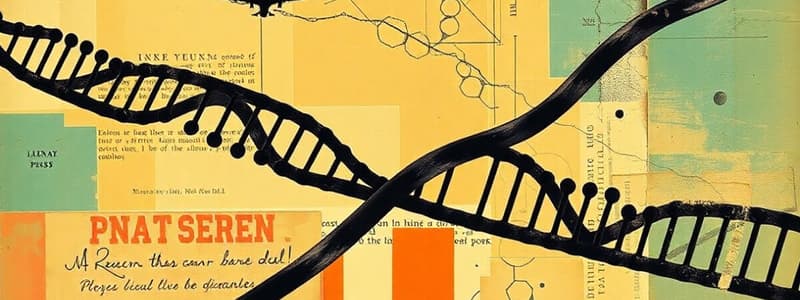Podcast
Questions and Answers
What sugar is found in the structure of ribonucleic acid (RNA)?
What sugar is found in the structure of ribonucleic acid (RNA)?
- Glucose
- Ribose (correct)
- Fructose
- Deoxyribose
Which base is present in RNA instead of thymine, which is found in DNA?
Which base is present in RNA instead of thymine, which is found in DNA?
- Adenine
- Guanine
- Uracil (correct)
- Cytosine
What process forms messenger RNA (mRNA) from DNA?
What process forms messenger RNA (mRNA) from DNA?
- Translation
- Translocation
- Replication
- Transcription (correct)
In eukaryotic cells, where is ribosomal RNA (rRNA) produced?
In eukaryotic cells, where is ribosomal RNA (rRNA) produced?
What role does transfer RNA (tRNA) play in protein synthesis?
What role does transfer RNA (tRNA) play in protein synthesis?
Which type of RNA carries genetic information from the nucleus to the ribosomes?
Which type of RNA carries genetic information from the nucleus to the ribosomes?
What is the primary function of ribosomes?
What is the primary function of ribosomes?
How many different amino acids does tRNA transfer?
How many different amino acids does tRNA transfer?
What structure may ribosomes be found attached to?
What structure may ribosomes be found attached to?
What describes the structure of RNA compared to DNA?
What describes the structure of RNA compared to DNA?
What is the primary function of the transport vesicle in protein synthesis?
What is the primary function of the transport vesicle in protein synthesis?
Why is the genetic code considered to be a triplet code?
Why is the genetic code considered to be a triplet code?
What role do stop codons play in protein synthesis?
What role do stop codons play in protein synthesis?
What is the process of removing introns from the primary mRNA called?
What is the process of removing introns from the primary mRNA called?
What is the purpose of adding a poly-A tail to mRNA?
What is the purpose of adding a poly-A tail to mRNA?
How does alternative mRNA splicing affect protein diversity?
How does alternative mRNA splicing affect protein diversity?
What is the role of transfer RNA (tRNA) during translation?
What is the role of transfer RNA (tRNA) during translation?
Which statement about the genetic code is true?
Which statement about the genetic code is true?
What is the significance of the codon GGG in protein synthesis?
What is the significance of the codon GGG in protein synthesis?
What is the first step in the process of transcription?
What is the first step in the process of transcription?
Flashcards are hidden until you start studying
Study Notes
RNA Structure and Function
- RNA contains ribose sugar, adenine, uracil, cytosine, and guanine bases.
- RNA is single-stranded, but can fold back on itself for base pairing.
- RNA acts as a helper to DNA, enabling protein synthesis.
Types of RNA
- Messenger RNA (mRNA): Carries genetic information from DNA in the nucleus to ribosomes in the cytoplasm for protein synthesis.
- Transfer RNA (tRNA): Transfers amino acids from the cytoplasm to ribosomes for protein synthesis, with each amino acid having a specific tRNA molecule.
- Ribosomal RNA (rRNA): Combines with proteins to form ribosome subunits (large and small), which are essential for protein synthesis.
Ribosomes and Protein Synthesis
- Ribosomes are the sites of protein synthesis.
- They can be free-floating in cytoplasm or clustered as polyribosomes.
- Ribosomes attached to the endoplasmic reticulum (ER) synthesize proteins for the ER.
- Free ribosomes or polyribosomes synthesize proteins for the cytoplasm.
The Genetic Code
- The genetic code uses a triplet code (codon) of three bases to code for a single amino acid.
- There are 61 codons that correspond to specific amino acids, and 3 stop codons signal the end of protein synthesis.
- Methionine's codon is also the start codon, initiating translation.
- Most amino acids have multiple codons, providing some protection against mutations.
Transcription
- Transcription is the process of creating RNA from a DNA template.
- RNA polymerase is an enzyme that binds to a promoter sequence on DNA, opening up the helix.
- RNA polymerase adds complementary RNA nucleotides to the template DNA strand, creating an mRNA molecule.
- The resulting mRNA transcript is a complementary copy of the DNA sequence.
mRNA Processing
- Newly synthesized primary mRNA undergoes processing to become mature mRNA.
- Processing involves:
- Capping: Adding a modified guanine nucleotide to the 5' end.
- Poly-A tail addition: Series of adenine nucleotides added to the 3' end.
- Splicing: Introns (non-coding regions) are removed, and exons (coding regions) are joined together.
- These modifications provide stability and ensure proper functionality of the mRNA molecule.
Translation
- Translation is the process of synthesizing proteins from mRNA instructions.
- It requires mRNA, tRNA, rRNA, and enzymes.
- tRNA: Carries amino acids to ribosomes, with each tRNA molecule recognizing a specific mRNA codon through its anticodon.
- The order of codons in mRNA determines the order in which tRNA molecules bind to ribosomes, dictating the sequence of amino acids in the protein.
- At the ribosome, amino acids are joined together to form a polypeptide chain.
Studying That Suits You
Use AI to generate personalized quizzes and flashcards to suit your learning preferences.




